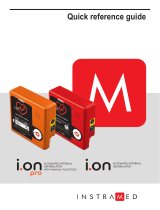
Table of Contents
ZOLL AED PLUS Administrator’s Guide iii
PREFACE .........................................................................................................................................................................V
SAFETY SUMMARY ........................................................................................................................................................VI
Warnings............................................................................................................................................................................ vi
Cautions ............................................................................................................................................................................ vii
Indications for Use............................................................................................................................................................vii
Contraindications for Use .................................................................................................................................................vii
Intended Users of the Device............................................................................................................................................ vii
Tracking Requirements....................................................................................................................................................viii
Notification of Adverse Events........................................................................................................................................viii
Unpacking........................................................................................................................................................................viii
Conventions .....................................................................................................................................................................viii
Symbols ............................................................................................................................................................................. ix
INTRODUCTION ...............................................................................................................................................................1
Using the ZOLL AED Plus................................................................................................................................................. 1
Using the CPR Function ..................................................................................................................................................... 2
OPERATION .....................................................................................................................................................................3
Operating Controls and Indicators...................................................................................................................................... 3
Using the ZOLL AED Plus Graphical User Interface ........................................................................................................ 5
Voice Prompts..................................................................................................................................................................... 6
Using the LCD Display....................................................................................................................................................... 9
Using the Passive Airway Support System (PASS) ......................................................................................................... 10
Using Electrodes ............................................................................................................................................................... 11
Applying CPR-D padz ...................................................................................................................................................... 12
Applying Pedi Padz II (Infant/Child Electrodes).............................................................................................................. 13
Using the CPR Monitoring Function -- Real CPR Help................................................................................................... 14
Using the Audio Recording Option .................................................................................................................................. 14
INSTALLATION AND SELF TEST ....................................................................................................................................15
Inspecting the Unit............................................................................................................................................................ 15
Preparing the ZOLL AED Plus for Use............................................................................................................................ 15
Using the Self Test Feature............................................................................................................................................... 16
Battery Installation Self Test ............................................................................................................................................................... 16
Power On Self Test ..............................................................................................................................................................................17
Manual Self Test .................................................................................................................................................................................. 17
Automatic Self Test .............................................................................................................................................................................18
Installing or Replacing Batteries....................................................................................................................................... 18
Identifying Battery Condition........................................................................................................................................... 20
MAINTENANCE AND TROUBLESHOOTING .....................................................................................................................21
Maintaining the Unit ......................................................................................................................................................... 21
Maintenance Checklist.........................................................................................................................................................................21
Cleaning the Unit .............................................................................................................................................................. 21
Optional Maintenance for Technical Professionals .......................................................................................................... 22
Troubleshooting ................................................................................................................................................................ 23
Contacting Technical Service ........................................................................................................................................... 24
International Customers.......................................................................................................................................................................24
ZOLL ADMINISTRATION SOFTWARE ...........................................................................................................................25
Installing ZOLL Administration Software ....................................................................................................................... 25
RescueNet Code Review Software ................................................................................................................................... 25
Setting Up Data Communications .................................................................................................................................... 25
ORDERING ACCESSORIES..............................................................................................................................................26
























